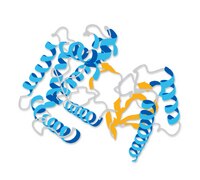228250 Sigma-AldrichCholesterol Oxidase, Streptomyces sp.
Cholesterol Oxidase, Streptomyces sp. CAS 9028-76-6, is a native cholesterol oxidase that catalyzes the oxidation of cholesterol to cholesterone and hydrogen peroxide.
More>> Cholesterol Oxidase, Streptomyces sp. CAS 9028-76-6, is a native cholesterol oxidase that catalyzes the oxidation of cholesterol to cholesterone and hydrogen peroxide. Less<<Synonyms: Cholesterol:oxygen oxidoreductase
Recommended Products
Overview
| Replacement Information |
|---|
Pricing & Availability
| Catalogue Number | Availability | Packaging | Qty/Pack | Price | Quantity | |
|---|---|---|---|---|---|---|
| 228250-500UCN |
|
Plastic ampoule | 500 u |
|
— |
| References | |
|---|---|
| References | Gadda, G., et al. 1997. Eur. J. Biochem. 250, 369. |
| Product Information | |
|---|---|
| CAS number | 9028-76-6 |
| Activity | ≥3 units/mg solid |
| Unit of Definition | One unit is defined as the amount of enzyme that will oxidize 1.0 µmol of cholesterol per min at 25°C, pH 7.0. |
| EC number | 1.1.3.6 |
| Form | Yellow lyophilized solid |
| Hygroscopic | Hygroscopic |
| Quality Level | MQ100 |
| Applications |
|---|
| Biological Information | |
|---|---|
| Specific Activity | ≥40 units/mg |
| Physicochemical Information | |
|---|---|
| Contaminants | Catalase: ≤1%; glucose oxidase and uricase: ≤0.01%. |
| Dimensions |
|---|
| Materials Information |
|---|
| Toxicological Information |
|---|
| Safety Information according to GHS |
|---|
| Safety Information |
|---|
| Product Usage Statements |
|---|
| Packaging Information |
|---|
| Transport Information |
|---|
| Supplemental Information |
|---|
| Specifications |
|---|
| Global Trade Item Number | |
|---|---|
| Catalogue Number | GTIN |
| 228250-500UCN | 04055977218176 |
Documentation
Cholesterol Oxidase, Streptomyces sp. SDS
| Title |
|---|
Cholesterol Oxidase, Streptomyces sp. Certificates of Analysis
| Title | Lot Number |
|---|---|
| 228250 |
References
| Reference overview |
|---|
| Gadda, G., et al. 1997. Eur. J. Biochem. 250, 369. |
















